Though Sepe Elye Wahi (184cm/6’0”, 74kg/163lbs) first broke into Montpellier’s first team in the second half of the 2020/21 season, the 19-year-old forward really started to shine last season, during the second half of which he firmly established himself as a regular starter.
Wahi ended the 2021/22 campaign with as many non-penalty goals (10) as PSG’s out-on-loan breakout star Arnaud Kalimuendo (who’s been linked with the likes of Premier League side Leeds United and Serie A giants Inter of late), tried and tested Ligue 1 goalscorer Gaëtan Laborde and global superstar Neymar — not bad company. His non-penalty xG (7.9, per Statsbomb via FBRef) was also very healthy, equalling that of Kalimuendo and trailing Neymar by just 0.4.
His impressive season led to the teenager being nominated for the Golden Boy award, alongside the likes of Real Madrid’s UEFA Champions League winner and former Rennes starlet Eduardo Camavinga, Borussia Dortmund’s Jude Bellingham and Barcelona’s Pedri, just to name a few.
Okay, let’s be realistic, Wahi won’t win the award but it’s still some well-earned recognition and a brilliant achievement for the 19-year-old Montpellier attacker, who came through the academy system at his current club along with, previously, Montfermeil, Caen and JS Suresnes — the latter being his first club, a fact he shares with N’Golo Kanté.
This tactical analysis and scout report aims to highlight what has made the Montpellier teenager explode onto the French football scene over the past year or so through analysis of his role within his team’s tactics, preferences on the pitch and key strengths. Furthermore, this analysis will focus on some of Wahi’s weaknesses too to show where the attacker could yet improve his game and take himself to another level.
Movement and shooting
Wahi is a natural, clinical finisher. That much is obvious from watching his performances for Montpellier over the past year and the wide range of finishes he’s pulled off, along with just observing how comfortable he is approaching the goal from all different angles and taking shots on from there.
Don’t take that to mean Wahi just shoots on sight — he’s got some of the best shot selection in France and his average shot distance (12.6m, per Statsbomb via FBRef) impressively ranks him in the 79th percentile for this particular metric among all forwards in Europe’s top-five leagues for the last calendar year, indicating that he takes his shots from relatively close to goal.
Wahi’s off-the-ball movement during the chance creation phase to create separation between himself and the defenders while moving into high-value areas plays a key part in his ability to routinely take shots from very close to goal, which we’ll analyse in figures 1-3.
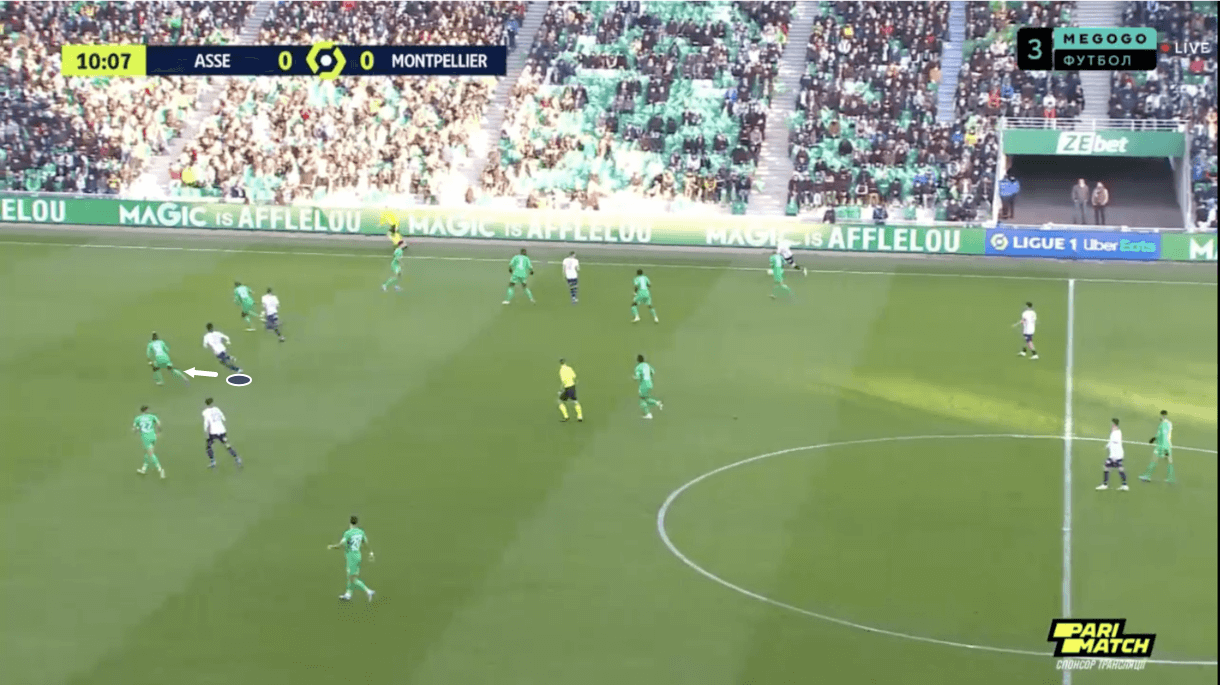
Figure 1 shows an example of Montpellier building from the middle third of the pitch into the final third, with Wahi placed in his preferred centre-forward position in this image, though we’ve seen the right-footed attacker operate from both the wide right and wide left forward positions at times this term.
Don’t expect to see Wahi offer himself up as an outlet for his teammates to use to escape pressure via a short ball to feet very often, as the 19-year-old much prefers to attack space behind the opposition’s backline, as we also see in figure 1. It’s very uncommon to see Wahi receive the ball to feet, that’s not his game and is actually a weakness in his game, which we’ll move on to later in this scout report.
Instead, expect to see Wahi sitting on the shoulders of the defenders 90% of the time, attentively watching and waiting for his teammate on the ball to make their move and launch the ball his way to spring his run in behind.
Wahi has decent pace and explosiveness in terms of his acceleration, which helps him to operate effectively in this role. However, his movement and alertness before the through ball is played is where he truly separates himself from the pack in this area.
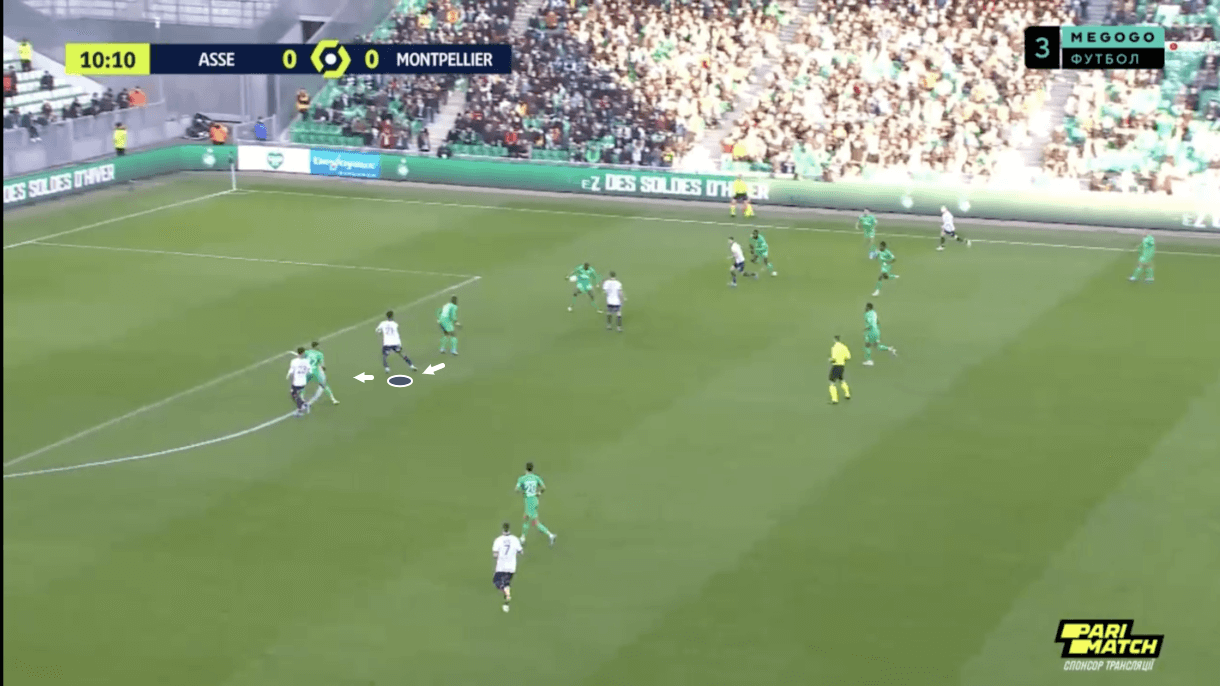
As the ball enters the final third, we see that Montpellier have just broken through Saint-Étienne’s backline with a through ball for the wide man to chase down. Just as that pass is played towards the right wing, Wahi intelligently creates separation between himself and the distracted defender between him and the ball, pulling away with a big step back on the defender’s blind side.
From here, the 19-year-old maintains this distance from the defender, allowing himself to enjoy plenty of space and actually double-up on the defender behind him in figure 2, with the attacker already occupying that player. The Montpellier duo make it impossible for the defender to cope with the two attackers via their movement.
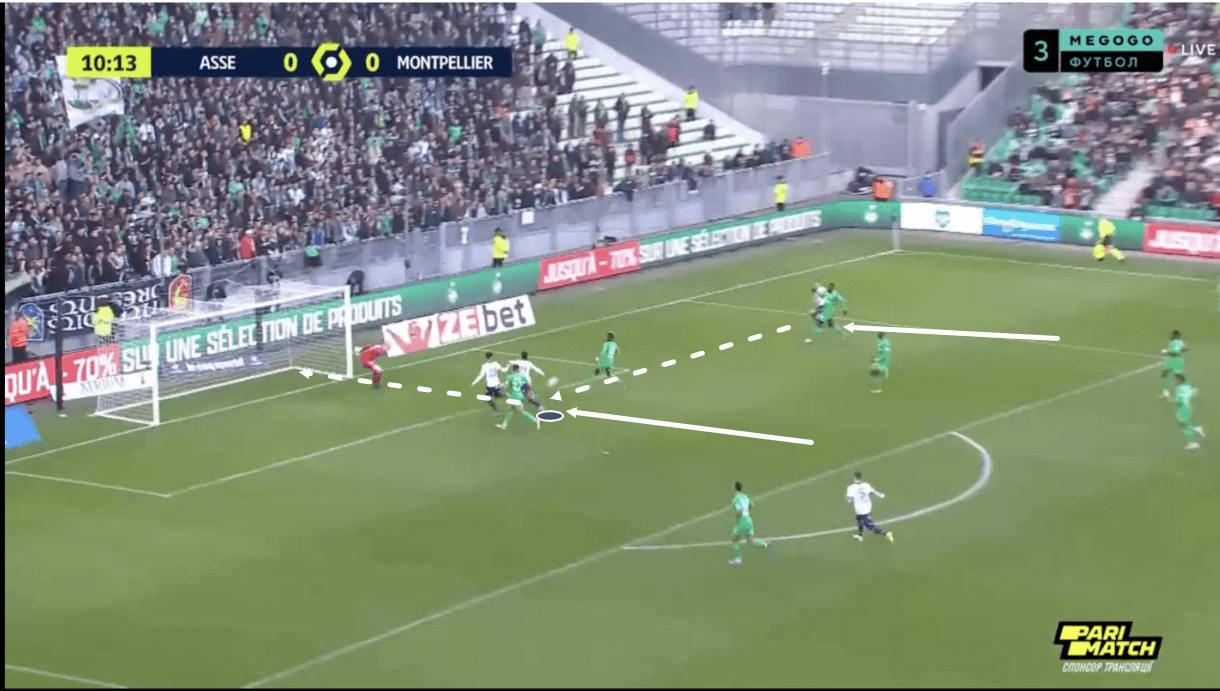
In all honesty, the two attackers get too close in figure 3 and should be spread out a little bit more. This would make it even more challenging for the defender to deal with them as he’d have to make a choice over which attacker to cover, which would then leave the other one free. Instead, the two attackers stand on top of each other as the play moves on into figure 3, with both wanting to get onto the end of this ball and neither of them making the unselfish run.
However, thanks to the separation he created and maintained with the defender in front of him, Wahi enjoyed enough space — in this high-value area — to watch the low cross get driven towards him, compose himself and slot the ball away at the near post. From this passage of play, we’ve caught a glimpse of some of the techniques that Wahi frequently displays in the chance creation phase to end up in a high-value position, close to the goal with plenty of space.
The teenager prioritises shot quality over shot quantity and tends to focus on occupying high-value positions to create a great goalscoring opportunity like this one rather than constantly looking to be on the ball. Wahi is happy to do a lot of his work off the ball and doesn’t need to be directly involved in the game all the time. Watch him move off the ball, as central and as far forward as he can possibly be. This is Wahi’s game, not just the explosive few seconds when the ball comes his way and it looks as though he just ends up in the right place at the right time.
Per Statsbomb via FBRef, Wahi ranks in just the 26th percentile for total shots when compared with forwards from Europe’s top-five leagues for the last calendar year. However, he ranks in the 87th percentile for shots on target percentage — indicative of his tendency to focus on quality over quantity in terms of his output in front of goal.
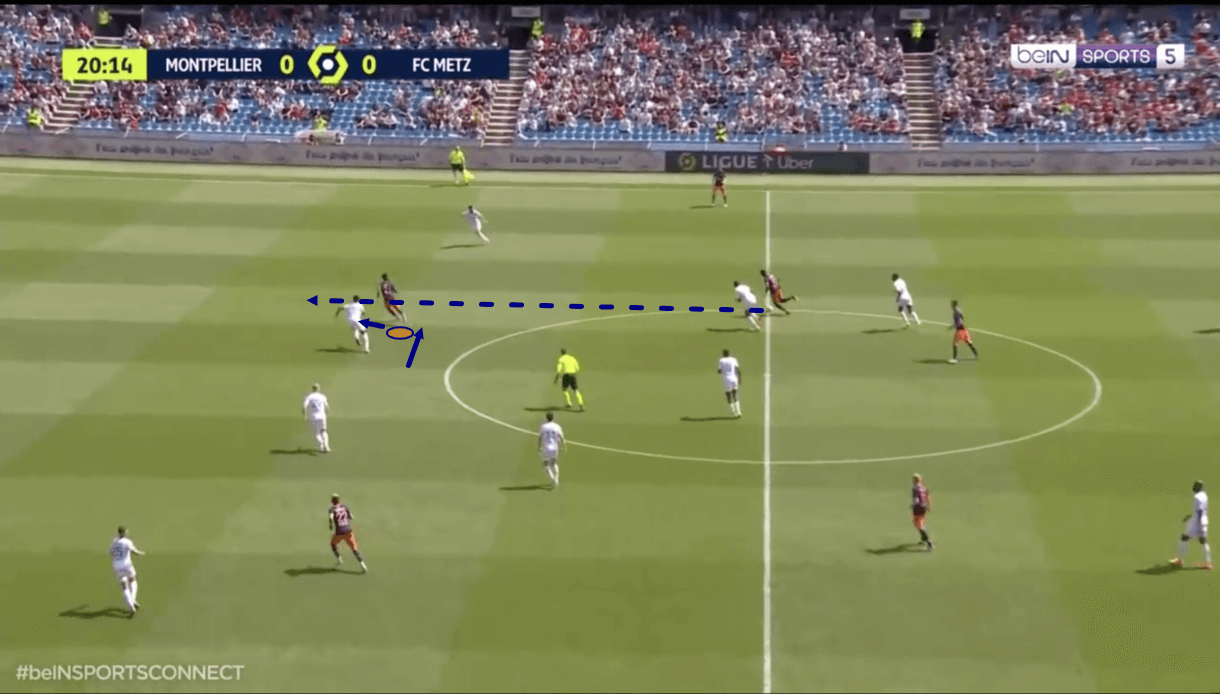
Wahi tends to time his runs excellently and is fairly good at keeping himself onside despite being an attacker that typically operates right on the opposition’s very last line. Just before figure 4, Wahi made his run with small steps to the right, opening up his body on this side to indicate to the passer exactly where he wanted the ball to be played.
His small-stepped run to the right allowed him to build some pace without becoming offside and entering a position he didn’t want to be in. He does well to hold his run until the passer plays the ball and in figure 4, we see the passer lifting his right foot before he sends the through ball Wahi’s way. At this moment, the attacker begins to shift his weight towards goal and move beyond the opposition’s backline, demonstrating a well-timed run thanks to his awareness and careful movement.
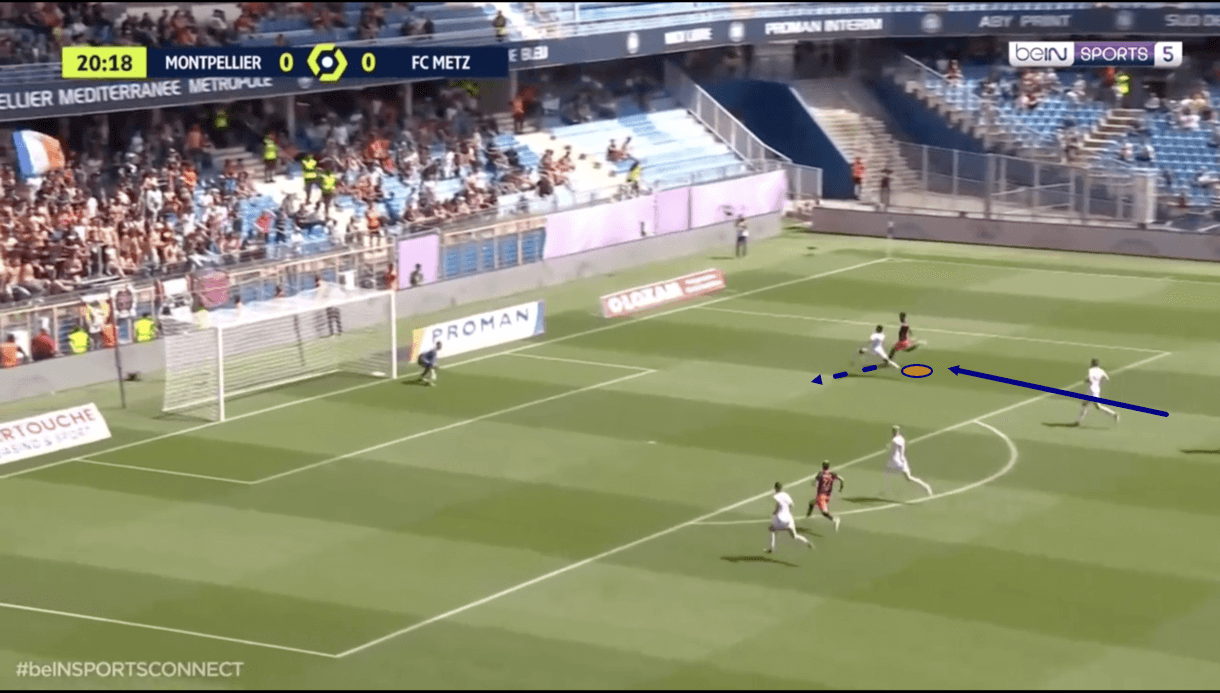
Wahi carries the ball into the opposition’s box and attempts a shot from a fairly awkward, wide right angle. While this doesn’t appear to be a brilliant shooting position, it should be noted again that Wahi has shown himself to be fairly comfortable shooting from the kind of angle we see him at in figure 5 and has scored from angles like this one — a result of his natural finishing quality. On this occasion, the defender does well to keep up with the attacker and block the shot, sending it out for a Montpellier corner.
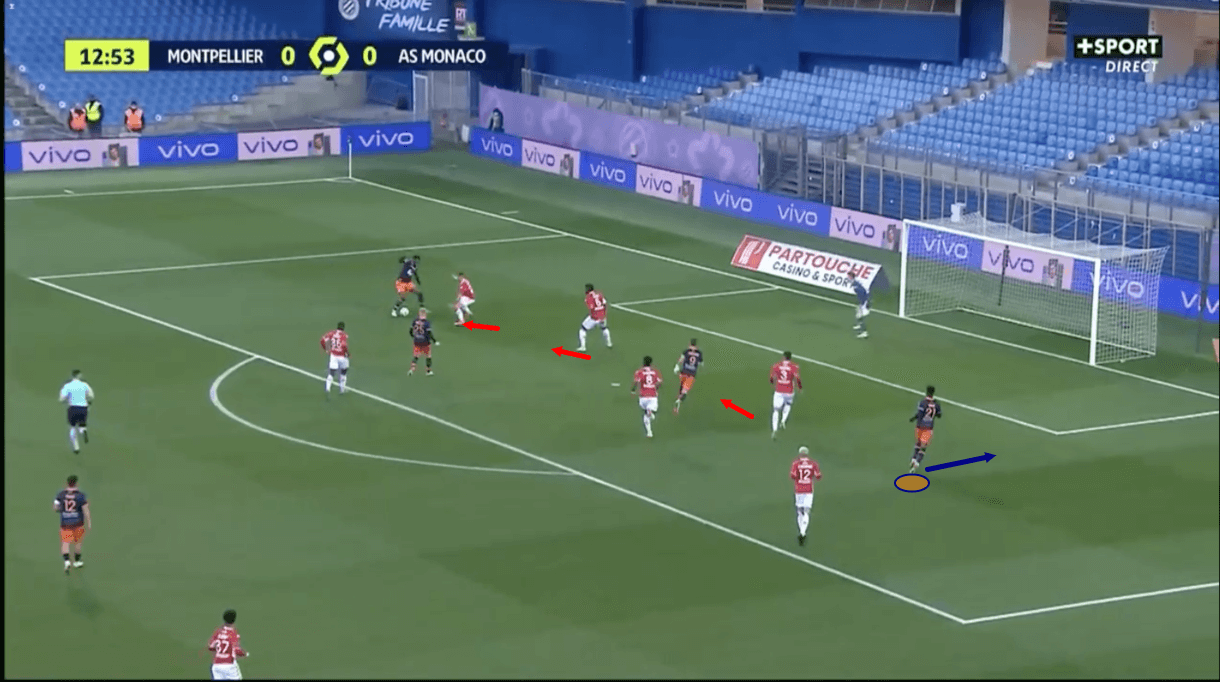
We want to look at one more example of Wahi’s off-the-ball movement to create separation from the defenders before ending this section of the analysis. In figure 6, Wahi’s teammate on the left side of the box is taking on an opposition full-back 1v1, which catches the attention of the whole opposition backline.
This leads to the right centre-back shifting over to provide cover behind that full-back, creating space for a Montpellier attacker to invade the space opening between the centre-backs. This then leads to the opposition’s left centre-back getting dragged towards that attacker, creating space for Wahi behind that defender on the blind side at the back post.
A combination of his teammates’ movement to attract the defenders and the opposition’s left-back not getting back allows the 19-year-old to enjoy far too much space here, making him a great threat, even though all of the attention is, understandably, on the threatening ball carrier at this moment.
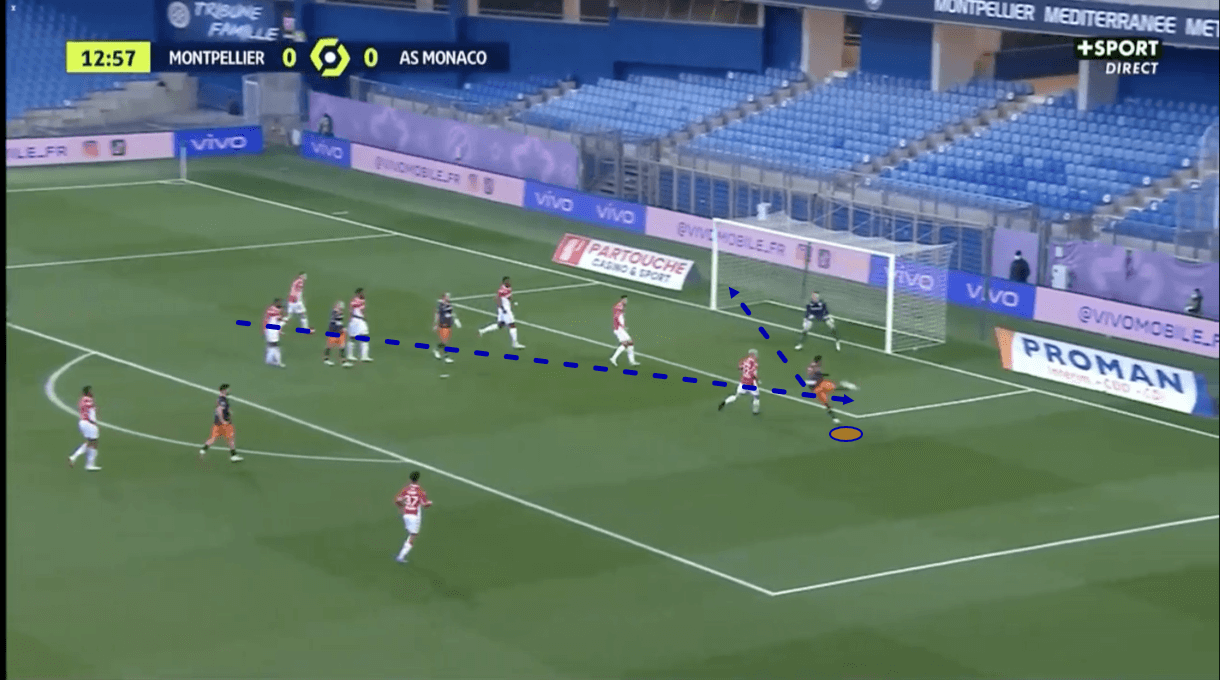
The ball carrier takes a shot which is deflected to the back post, where Wahi has time and space to calmly watch the ball bounce across his body onto his stronger right foot before driving it down on the bounce, across the goalkeeper into the net, as seen in figure 7.
Again, this passage of play highlights Wahi’s intelligent movement and spatial occupation in highly valuable areas close to the goal. However, this particular passage of play also demonstrates the attacker’s composure in front of goal. For a teenager, he never panics or snatches at opportunities, he remains calm and composed under pressure, putting himself in a good position mentally, as well as physically, to take the goalscoring opportunity.
Defensive qualities
Wahi has a strong defensive work rate and is very defensively active. He’s a good option for a team that likes to press aggressively from the front or for a team that needs the forward to track back and offer support at the back.
As mentioned previously, Wahi’s hold-up play isn’t good and he doesn’t typically offer his side the outlet at the centre-forward position to escape pressure quickly. As a result, he’s not really useful sitting up front while the team defends, unless the ball is sent very long for the attacker to chase in behind. Due to this and his solid defensive work rate, he’s far more valuable tracking back defensively and offering support in this way.
Wahi likes to defend aggressively and isn’t afraid to dive into tackles. He ranks in the 82nd percentile for tackles and 80th percentile for tackles won, per Statsbomb via FBRef, when compared with forwards from Europe’s top-five leagues over the last 365 days.
Montpellier are not the most aggressive side in France without the ball. They aren’t the most passive anymore, after swapping Michel Der Zakarian for Olivier Dall’Oglio last year, but are fairly average in terms of pressing intensity. Wahi is above average among forwards for pressures in general and performs fairly averagely for pressures in the final third and middle third, respectively.
For pressing in his own third, however, Wahi is a standout among forwards from Europe’s top-five leagues, with the teenager ranking in the 92nd percentile for that particular metric. This will no doubt be influenced by his team’s style and if he were playing for a team with a different defensive style, such as a high pressing unit, for example, he’d likely adapt his game and rank higher for pressures further upfield.
However, his duty with Montpellier is to track back and assist those positioned deeper than him to regain possession, and this is something he’s proven well able for as well as very willing to do.
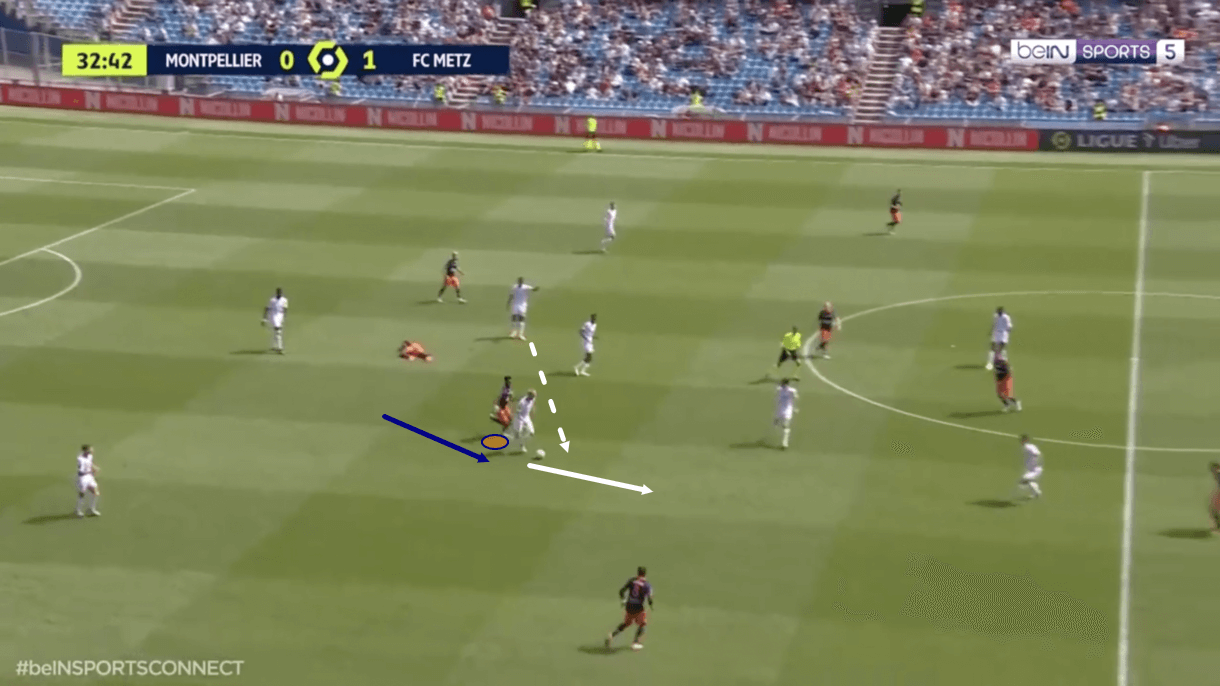
Just before figure 8, Montpellier were dispossessed in the final third, with the opposition springing a counterattack by playing the ball to a midfielder who aims to carry into the middle third of the pitch.
This player is positioned within Wahi’s zone, and as the ball is played to him, the attacker jumps into action without hesitation, tracking the ball carrier down as he drives into the middle third of the pitch to try and stop this opposition counterattack before it progresses to a very advanced stage.
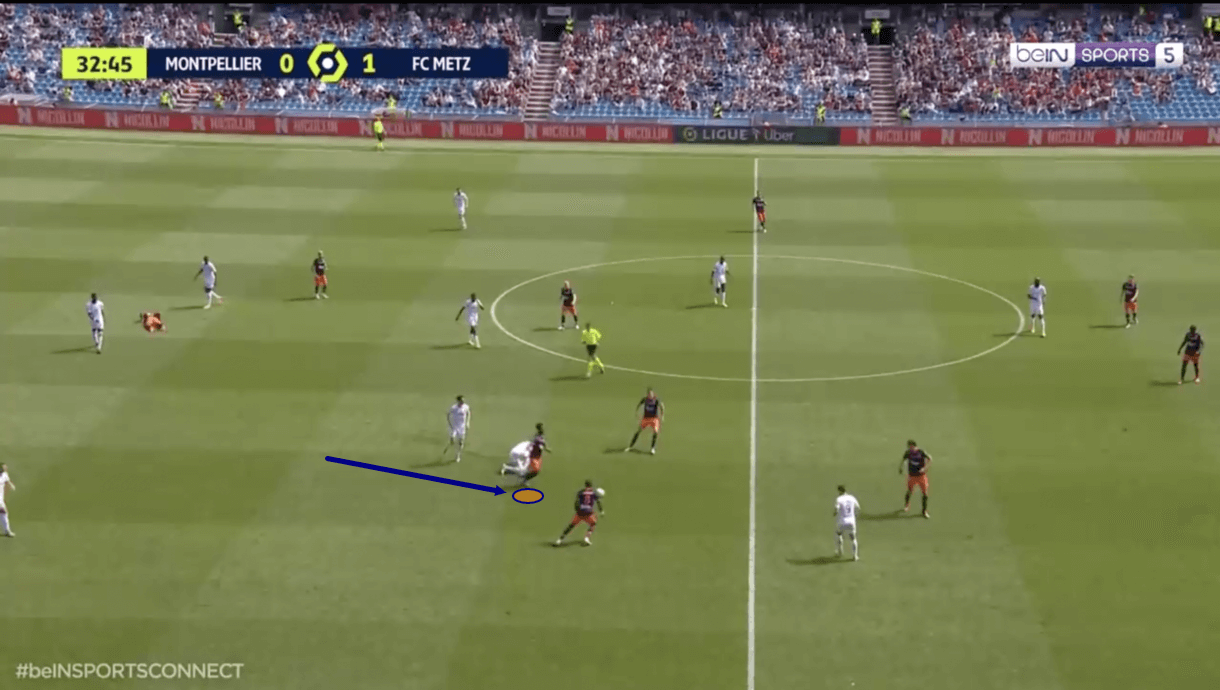
Between figures 8 and 9, Wahi dived into a tackle, won the ball and got back to his feet before the opposition player to end up where we see him in figure 9, in possession of the ball just inside the opposition’s half — where the counterattack was stopped.
Wahi’s awareness of the danger, explosive acceleration and solid defensive work rate led to a quick reaction that helped him to end this counterattack quickly, indicating how he can perform as a great defender from the front — another quality, along with his movement and goalscoring prowess, that have helped the teenager to become a first-team regular for Montpellier.
Areas of improvement
The final section of our analysis will focus on three specific areas in which the 19-year-old attacker can yet improve his game — aerial ability, passing and dribbling.
While the 19-year-old moves very effectively off the ball, and this helps his team to create chances as he makes himself an option in high-value positions as mentioned earlier, Wahi doesn’t offer much on the ball in the chance creation phase at all.
He very rarely makes himself an option for teammates to link up with on the ball, which is one thing he lacks as a centre-forward and can create problems for his teammates in deeper areas or in more advanced areas when they need an outlet to aim for, and on the rare occasions when he does make himself an option for teammates in this way, he doesn’t possess great technical ability in tight areas to complete the move very well, so this is certainly an area in which he can improve.
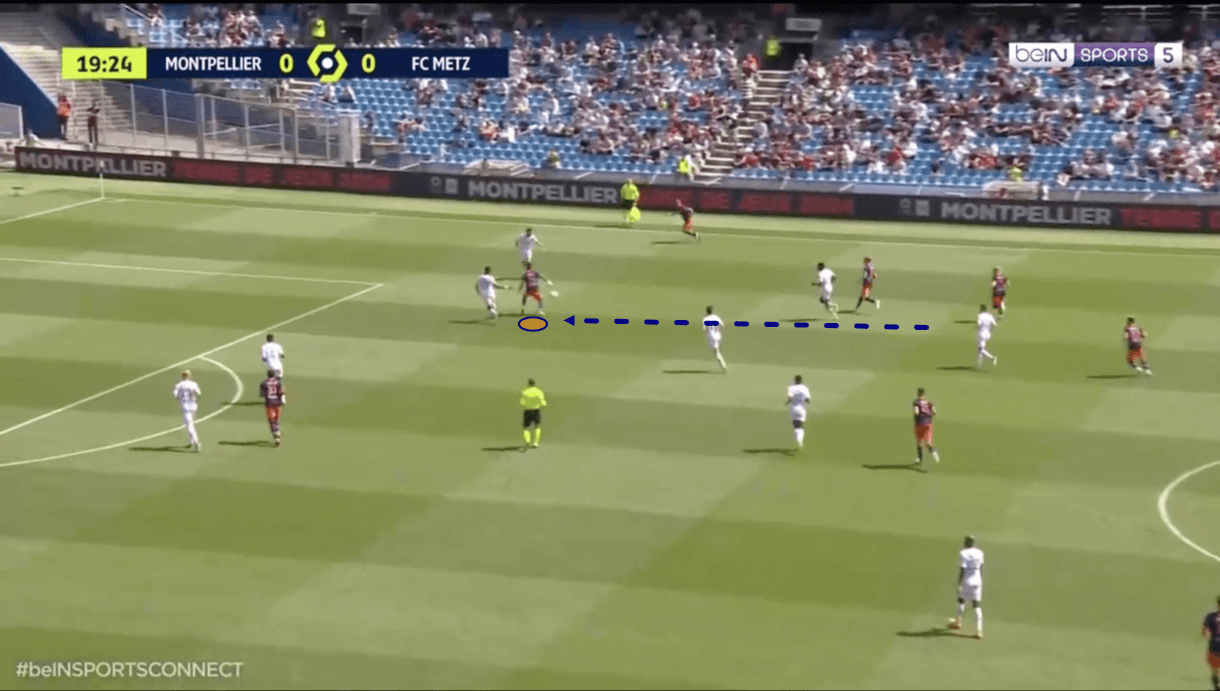
In figure 10, for example, Wahi receives the ball at his feet, not into space. He has very little room to operate in here, with the full-back closing him down as well as the defender on his back. His first touch is okay but a bit heavy, as is often the case.
The pressing concern from the occasions when the 19-year-old does receive the ball to feet, though, is that Wahi can do a better job of scanning in situations like this to make himself more aware of the options he has. For example, as the full-back closes him down here, the overlapping wide man could be an option. However, the striker doesn’t do enough to make himself aware of this option.
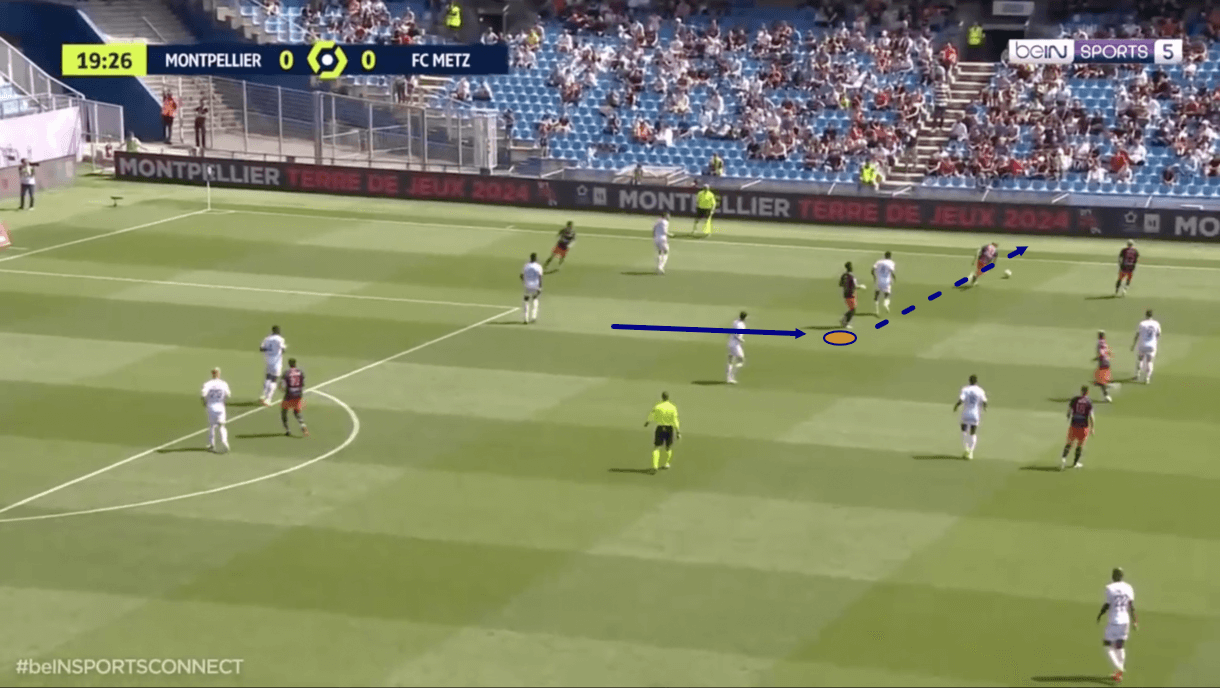
As the play moves on into figure 11, the overlapping teammate’s run comes to nothing as Wahi doesn’t take that option, and the attack in its entirety fizzles out as Wahi’s pass is not good enough at all, is misdirected and powered poorly, leading to the ball going out of play for an opposition throw-in.
This is just one example of Wahi’s passing quality letting him down; we’ve seen plenty of examples like this since the attacker has been in senior football and it’s an area in which he can clearly improve. We’re not saying Wahi needs to become an elite playmaker by any means but it wouldn’t take an elite playmaker to do better in this situation.
Wahi must scan more and improve his spatial awareness to ensure good passing options aren’t passed up, while the 19-year-old must also improve his technical passing ability to weigh passes and direct passes better and enable himself to help his team out more in the final third.
The same can be said of Wahi’s technical dribbling ability as we’ve said about his passing ability. The attacker has demonstrated decent ability on the ball when driving into space or when facing a defender head-on, particularly in terms of his agility, while he also appears far more confident in these types of situations. That said, his quality is not at a good enough standard for Ligue 1, still.
However, just like with his passing, the real problems come when Wahi has his back to goal and defenders swarming him. So, the attacker’s ball control and general hold-up play can do with some improvement.
Lastly, Wahi is very poor in the air and tying back in with his hold-up play, the attacker can work on building some more functional strength, as well as building the confidence to use it against Ligue 1 defenders. The French top-flight is a very physical league and it’s to be expected that a teenager will struggle at times against Ligue 1’s centre-backs.
However, Wahi is now a senior player and with that comes the responsibility to work on himself physically and get more comfortable with imposing himself on defenders and backing into them. Wahi is a decent height but can build more muscle and strength to fill out his frame; should he do this, he’ll add another element to his game and likely enjoy more minutes as an out-and-out centre-forward, as this is probably the number one thing leading to his occasional minutes out wide still.
Wahi must enter aerial duels more confidently and more explosively. He doesn’t have a great jumping height but he also doesn’t often give himself much of a chance with half-hearted leaps being a semi-regular occurrence. He needs to stamp this out of his game and perhaps even study the likes of Steve Mounie — an aerial monster — to see if there are one or two habits he could look to add to his own game.
Conclusion
To conclude this analysis, it’s clear that Wahi is an exciting player with plenty of natural ability in front of goal. He’s a clinical finisher who frequently displays impressive off-the-ball movement, while he’s very active defensively too, which indicates a good mentality and work rate.
However, Wahi can still improve in plenty of key areas, including aerial ability and some key technical areas — passing and dribbling. If he makes some improvements in those areas while continuing to hone those skills he’s already adept at, Wahi will continue to grow and it’ll be exciting for Montpellier, in particular.





Comments